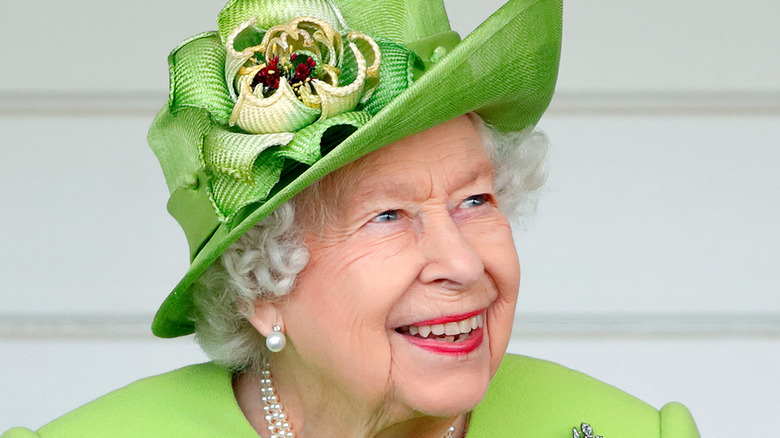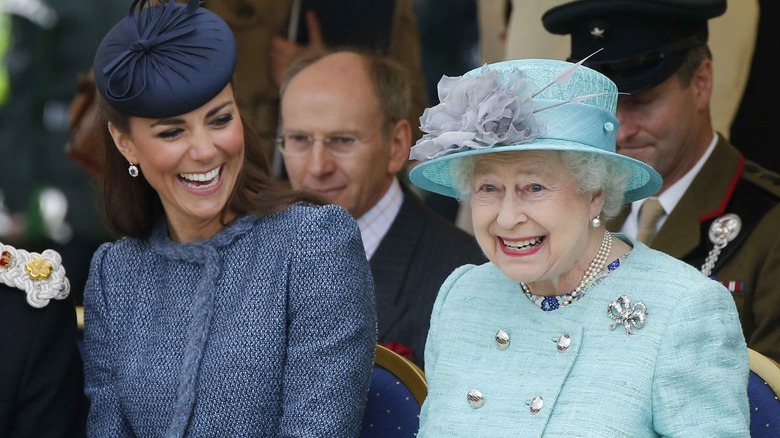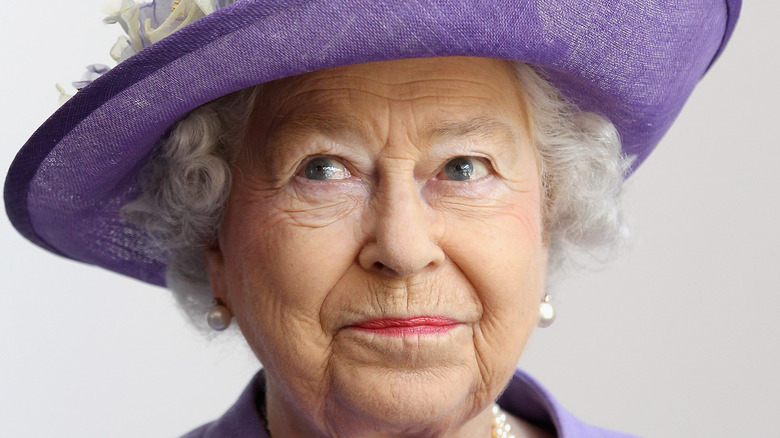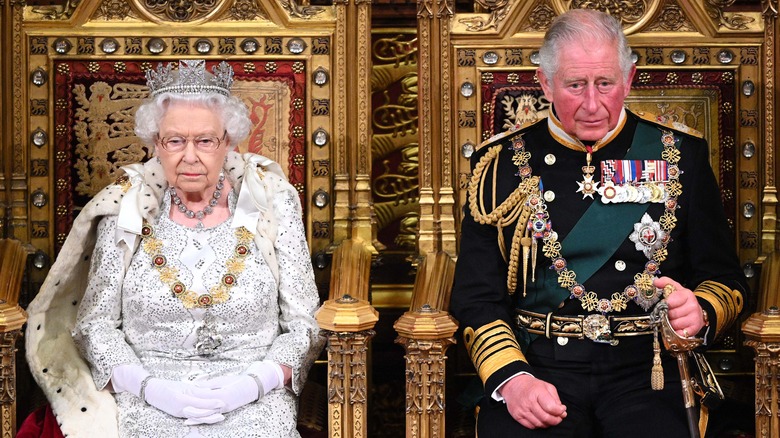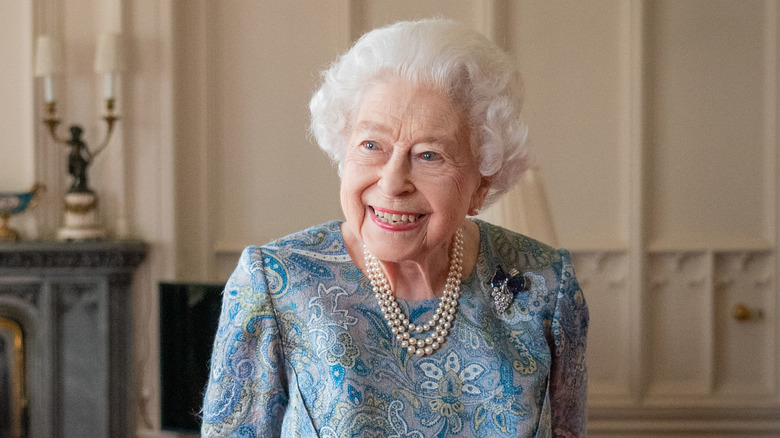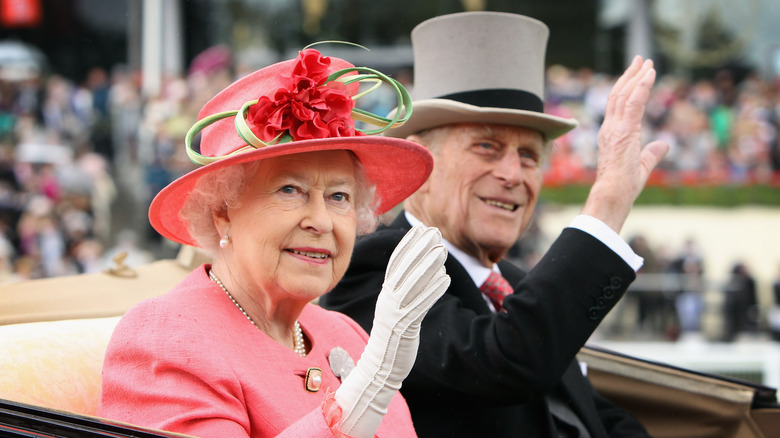Queen Elizabeth II's Net Worth At The Time Of Her Death Might Surprise You
Long-reigning monarch Queen Elizabeth II passed away on September 8, 2022 at the age of 96, as confirmed by The Royal Family. Early on Thursday, Buckingham Palace released an official statement indicating that Her Majesty was "under medical supervision," per her doctors' advisement (via Twitter). The beloved ruler, who celebrated her Platinum Jubilee — marking 70 years on the throne — in June 2022, had endured highly-publicized health issues in the preceding years. Her Majesty was even forced to sit out a number of events at her own Jubilee due to mobility troubles, as The Telegraph reported (via Vanity Fair), ultimately leading to a fast-tracked revision of her official duties.
Queen Elizabeth's son, Prince Charles, was ready to take over, with the palace working away in the background to make the transition as smooth as possible, per Page Six. As the managing editor of Majesty magazine, Joe Little, explained, the changeover of power became a more pressing concern due to Her Majesty's "fluctuating health." Although Britons were prepared for her death, it still came as a huge shock to the system. The queen was also sitting on a massive fortune when she passed, of course, the details of which are even more startling.
Queen Elizabeth II had a massive personal fortune
Celebrity Net Worth confirms that Queen Elizabeth II was sitting on an eye-watering $600 million fortune when she died. The beloved monarch was also in control of a whopping $28 billion in additional assets, while the Crown Estate was worth $19 billion. Additionally, the Estate generated around $450 million in profit annually, of which the queen was entitled to 25%.
It's worth noting that Her Majesty's personal fortune is only an estimate, so it's likely she was actually worth more, particularly considering that the queen owned two castles — Sandringham House and Balmoral — in Scotland. Buckingham Palace, meanwhile, is worth $5 billion alone. Suffice to say, Queen Elizabeth was wealthier than most of us could comprehend.
She was born into incredible wealth, as her parents were the Duke and Duchess of York (her father was the second son of King George V). Likewise, Her Majesty ascended to the throne much earlier than anticipated. Britannica notes she became queen when King George VI died in 1952. Her Majesty was just 25 years old at the time. George's predecessor, King Edward VIII, infamously abdicated to marry American socialite Wallis Simpson.
Her Majesty had an expansive property portfolio
As Town & Country details, Queen Elizabeth II had a number of stylish homes to choose from throughout her reign, from the wide expanse of Buckingham Palace to the cozier confines of Windsor Castle. Her Majesty actually moved to Windsor Castle permanently in early 2022 after stepping back from many of her public duties, per the Times of London (via the New York Post). However, many of these properties weren't personally owned by the queen.
They were simply used by the reigning monarch of the time. Holyrood Palace, in Edinburgh, is the official residence of the British ruler but didn't necessarily belong to the queen even though she was free to use it whenever she pleased. Likewise, Hillsborough Castle, located in Northern Ireland, is also an official residence rather than a personal one. Even so, Queen Elizabeth had an impressive property portfolio regardless.
Architectural Digest points out that Windsor Castle, with its 1,000+ rooms and more than 13 acres of land, "is the largest occupied castle in the world." Her beloved Balmoral Castle, meanwhile, sits on 50,000 acres and features 150 buildings in total. Hello! confirms both Balmoral and Sandringham were privately owned by the queen, so one of her lucky children will likely inherit them following her passing.
Christmas is held annually at Sandringham, while Balmoral is typically used for summer getaways.
The queen's jewelry collection was awe-inspiring
Unsurprisingly, given she was born into royalty, Queen Elizabeth II also owned an impressively large stack of jewelry. The general royal collection includes paintings, tapestries, jewels, clothing, and plenty of other valuable items. The queen herself, meanwhile, owned a considerable amount of tiaras, brooches, and other pieces, which had an estimated combined worth of $110 million, per Forbes.
Tatler cataloged some of her most impressive acquisitions, including the stunning Imperial State Crown, which was displayed next to Prince Charles when he took over the State Opening of Parliament in his mother's place in 2022. The piece features 2,868 diamonds, 17 sapphires, 11 emeralds, and 269 pearls, and dates back to 1937, and the coronation of King George VI. It had to be shortened by one inch for Queen Elizabeth.
Elsewhere, the so-called Crown Amethyst Suite of Jewels boasts a matching diamond brooch, earrings, and necklace, while the queen inherited the Crown Ruby Necklace when her own mother passed away in 2002. Her Majesty's engagement ring, a "three-carat diamond solitaire," was created using stones from a tiara belonging to Prince Philip's dearly departed mother, Princess Alice. Queen Elizabeth II glittered at all times, to say the least.
Queen Elizabeth also received a wage from the British government
Aside from her personal fortune and impressive assets, Queen Elizabeth II also, somewhat controversially, received a regular stipend from the British government. According to CNBC, she even got a raise of almost 78% in 2018/2019. The Sovereign Grant Report, which details how much money Her Majesty received over the previous financial period — alongside what the royals spent, too — confirmed she earned £76.1 million (nearly $100 million) from April 1, 2017, to March 31, 2018.
From 2018 to 2019, meanwhile, the royal household confirmed an increase to £82.2 million (almost $108 million). The jump was put down to extensive renovations at Buckingham Palace, which included overhauling the electrics, pipework, and heating and cooling systems, among other things. Elsewhere, the queen also spent more over this particular period, with her "official expenditure" increasing by 13%, from £41.9 million ($55 million) in 2016/17 to £47.4 million ($62.2 million) for 2017/18.
This can, again, predominantly be attributed to the renovations. The Sovereign Grant paid for Her Majesty's official duties, as well as the upkeep of the palaces and staffing costs. However, Elizabeth also used income from her own considerable investment portfolio to fund her lifestyle. Even so, the U.K. is split on whether taxpayers should continue paying the royals' way, according to an Ipsos poll cited by Bloomberg.
As People noted, the queen's use of the Royal Train to travel to Balmoral in June 2021 for the G7 summit cost Britons $38,400 alone.
The beloved monarch enjoyed an incredibly luxurious life
Queen Elizabeth II lived an insanely lavish life, that much is clear. Alongside her impressive art collection, bulging property portfolio, and to-die-for jewelry pieces, Her Majesty owned racehorses (per Britannica), had her own personal chef (via Geo News), and even traveled on her own private plane (per CNBC). She also had expensive taste. According to The Telegraph (via Town & Country) Queen Elizabeth owned more than 200 handbags from high-end British designer Launer.
The queen developed a love of the bags after being gifted one by her mother when she was a child. Her Majesty's car collection was reportedly worth around $10 million, according to Business Insider, featuring custom Bentleys, Rolls-Royces, a Jaguar Daimler V8 Super LWB, and more. Queen Elizabeth wasn't known for carrying cash around with her, though, despite the fact she had her own personal ATM installed in the basement of Buckingham Palace sometime around 2001, as reported by Vogue.
The long-reigning monarch was so wealthy, she had an employee on hand to break in her shoes for her, as noted by the Evening Standard. Royal insider Stewart Parvin explained succinctly, "The shoes have to be immediately comfortable ... The queen can never say 'I'm uncomfortable, I can't walk anymore.'" He added, "She has the right to have someone wear them in." This person was separate from her ladies-in-waiting, i.e. staffers tasked with helping Her Majesty with anything she needed.
Queen Elizabeth II's long reign will be fondly remembered.
